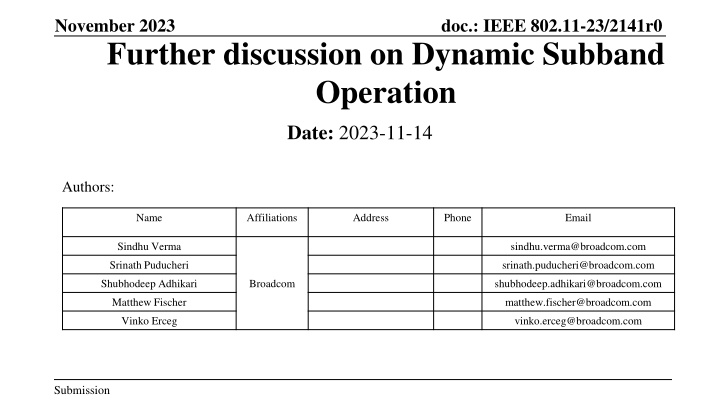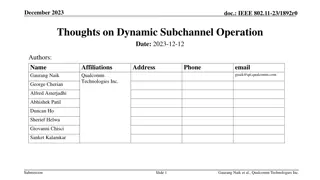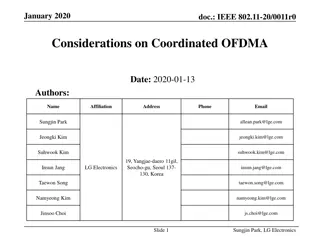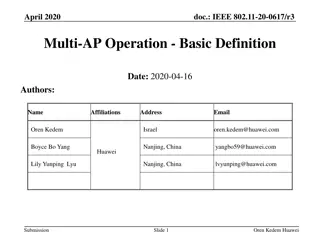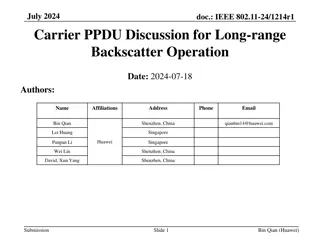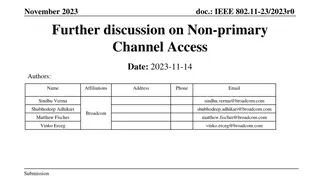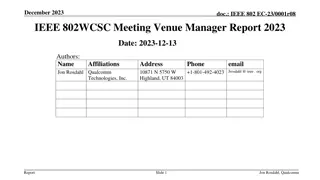IEEE 802.11-23/2141r0 Dynamic Subband Operation Discussion
Discussion on Dynamic Subband Operation in IEEE 802.11-23/2141r0 focusing on enabling flexible bandwidth allocation between APs and non-APs for improved resource utilization and system performance. The proposal aims to address bandwidth mismatches and enhance efficiency in channel access allocation based on bandwidth availability, channel conditions, and quality of service requirements.
Download Presentation

Please find below an Image/Link to download the presentation.
The content on the website is provided AS IS for your information and personal use only. It may not be sold, licensed, or shared on other websites without obtaining consent from the author.If you encounter any issues during the download, it is possible that the publisher has removed the file from their server.
You are allowed to download the files provided on this website for personal or commercial use, subject to the condition that they are used lawfully. All files are the property of their respective owners.
The content on the website is provided AS IS for your information and personal use only. It may not be sold, licensed, or shared on other websites without obtaining consent from the author.
E N D
Presentation Transcript
doc.: IEEE 802.11-23/2141r0 November 2023 Further discussion on Dynamic Subband Operation Date: 2023-11-14 Authors: Name Affiliations Address Phone Email Sindhu Verma sindhu.verma@broadcom.com Srinath Puducheri srinath.puducheri@broadcom.com Shubhodeep Adhikari Broadcom shubhodeep.adhikari@broadcom.com Matthew Fischer matthew.fischer@broadcom.com Vinko Erceg vinko.erceg@broadcom.com Submission
doc.: IEEE 802.11-23/2141r0 Overview Background Dynamic Subband Operation Protocol details Capability details Straw Polls Submission Slide 2
doc.: IEEE 802.11-23/2141r0 Background 802.11be supports 320MHz as the maximum bandwidth of operation on any one link. 802.11bn may support even higher State of the art 802.11bn APs are expected to support at least 320MHz bandwidth of operation However, many 802.11bn non-APs may support only a smaller bandwidth (160MHz or lower) as the maximum bandwidth of operation. Such mismatch in the capabilities between the AP and the non-AP would result in wastage of bandwidth capabilities of the AP whenever the AP interacts with smaller bandwidth non-APs. In [2], a scheme Dynamic Subband Operation was proposed to overcome this limitation by allowing the 320MHz AP to dynamically indicate to a lower bandwidth non-AP, Tx/Rx opportunity outside of its operating bandwidth Submission Slide 3
doc.: IEEE 802.11-23/2141r0 Dynamic Subband Operation The scheme is applicable to any AP/non-AP bandwidth combinations where the bandwidth supported by the AP is higher than the non-AP. Dynamic Subband Operation can enable the AP to utilize its additional bandwidth in a dynamic manner on a per-TXOP basis whenever it wins channel access on it. The AP can dynamically decide to allocate non-APs on different parts of its operating bandwidth and the non-APs to allocate in this manner depending on bandwidth availability, channel conditions and QoS requirements This results in much better resource utilization and system performance compared to HE SST. The operation could be DL or trigger-based UL inside each dynamically allocated opportunity Submission Slide 4
doc.: IEEE 802.11-23/2141r0 Applicability and use cases of Dynamic Subband Operation (1) There is an argument that the real difference between AP and client bandwidths is much lower than the difference in their max supported bandwidths. This is because managed 802.11 deployments usually split the available bandwidth into narrower bandwidths with different primary channels and allocate different BSSs to these narrower bandwidths. So, there are rarely wide bandwidth BSSs outside of sparse residential deployments. Thus, the problem that DSO is proposing to solve is not that acute in reality. The foremost reason why managed deployments split the available bandwidth into multiple narrower bandwidths is to reduce the problem of primary channel blocking i.e. where even a single busy primary channel can block access to the entire wider bandwidth, even if the non-primary portions of the bandwidth are idle. Such frequency planning is complex. It is also inefficient. For example, an application within a BSS is only able to use the narrower bandwidth of the BSS and not anything wider, even if spare adjacent bandwidth is available in other BSSs. Submission Slide 5
doc.: IEEE 802.11-23/2141r0 Applicability and use cases of Dynamic Subband Operation (2) Non-primary channel access will solve this problem cleanly for devices that are capable of such channel access. Such devices can all share the same primary within the widest possible bandwidth and opportunistically use any available bandwidth with or without the primary. Submission Slide 6
doc.: IEEE 802.11-23/2141r0 A frequency-reuse 1 deployment enabled by non-primary channel access (2) Such wideband frequency reuse 1 operation has the following challenges and solutions: Inefficiency due to the disparity in bandwidths supported by the AP and non-AP: For example, if there are many 80MHz clients in a 320MHz BSS, it could lead to wasting bandwidth whenever the AP is able to schedule only these narrower bandwidth capable clients in a PPDU/TXOP. This problem would be solved by a complementary feature, that of Dynamic Subband Operation ([5] and [6]). DSO will ensure that an AP is able to move narrower bandwidth clients to any part of the wider BSS bandwidth and thus efficiently pack the entire wider bandwidth. Increased non-AP power consumption due to listening on wideband channels: This problem too would be solved by a complementary feature on non-AP power save ([7] and [8]). This feature would allow a non-AP to listen on only 20MHz per link, with 1 NSS and low MCS. Any transmission by the AP to such a non-AP would be preceded by an Initial Control Frame (similar to EMLSR) that would provide the non-AP with information on the bandwidth, NSS and max MCS of the subsequent frame exchanges. Configurable padding in the ICF would also allow the non-AP to switch to the required bandwidth/NSS/max MCS capabilities after receiving the ICF. Submission Slide 7
doc.: IEEE 802.11-23/2141r0 Protocol details The AP sends to the DSO non-AP being scheduled, a "subband-switch control frame", which is a special initial control frame (could be a modified MU-RTS or BSRP or a newly defined frame) that indicates transition to the RU outside the operating bandwidth The subband-switch control frame has sufficient padding to cover subband switch latency (i.e. latency required by the non-AP to switch from its operating bandwidth to the indicated RU The subband switch latency depends on the non-AP implementation and is negotiated during the DSO capability signaling. Depending on the negotiated capabilities of the DSO-capable non-AP, the following options are possible: Option 1: The subband-switch initial control frame is used only for subband switch by DSO non-APs and does not elicit any response. SIFS later, the AP sends a second control frame (which can be a regular MU-RTS/BSRP) that elicits a response in the new RU Option 2: The subband-switch initial control frame is used for subband switch by DSO non-APs and elicits a response in the new RU. This is especially possible if post-FCS MAC padding ([3]) is used The subband-switch initial control frame may be in non-HT duplicate format, again depending on the negotiated capabilities. Thereafter, the DSO TXOP can contain multiple SIFS-spaced DL/triggered UL exchanges with the DSO non-APs. At the end of the TXOP (for example, detected through a gap of SIFS+delta time), the DSO non-AP switches back to operating on its operating bandwidth overlapping the primary 20MHz. Submission Slide 8
doc.: IEEE 802.11-23/2141r0 Protocol details The AP sends to the DSO non-AP being scheduled, a "subband-switch control frame", which is a special initial control frame (could be a modified MU-RTS or BSRP or a newly defined frame) that indicates transition to the RU outside the operating bandwidth The subband-switch control frame has sufficient padding to cover subband switch latency (i.e. latency required by the non-AP to switch from its operating bandwidth to the indicated RU The subband switch latency depends on the non-AP implementation and is negotiated during the DSO capability signaling. Depending on the negotiated capabilities of the DSO-capable non-AP, the following options are possible: Option 1: The subband-switch initial control frame is used only for subband switch by DSO non-APs and does not elicit any response. SIFS later, the AP sends a second control frame (which can be a regular MU-RTS/BSRP) that elicits a response in the new RU Option 2: The subband-switch initial control frame is used for subband switch by DSO non-APs and elicits a response in the new RU. This is especially possible if post-FCS MAC padding ([3]) is used The subband-switch initial control frame may be in non-HT duplicate format, again depending on the negotiated capabilities. Thereafter, the DSO TXOP can contain multiple SIFS-spaced DL/triggered UL exchanges with the DSO non-APs. At the end of the TXOP (for example, detected through a gap of SIFS+delta time), the DSO non-AP switches back to operating on its operating bandwidth overlapping the primary 20MHz. Submission Slide 9
doc.: IEEE 802.11-23/2141r0 Schematic diagram for Dynamic Subband Operation (Option 1) SIFS SIFS SIFS SIFS + delta Second control frame 160S Subband switch control frame (with padding for DSO) AP 160P Rx second control frame (on 160S) Tx 320 MHz DL/UL OFDMA Response (on 160S) 160S DSO STA Rx subband switch control frame (on 160P) Switch back to 160P 160P 160S non DSO STA Rx second control frame (on 160P) Tx Rx subband switch (on 160P) Response (on 160P) 160P 10 Submission
doc.: IEEE 802.11-23/2141r0 Capability details (1) Whether the non-AP/AP support DSO Operating bandwidth of the non-AP/AP A non-AP bandwidth of 20MHz, 40MHz, 80MHz, 160MHz can be supported within any larger operating bandwidth of the AP. The scheme should allow smaller bandwidth non-APs to accommodate any low power non-AP implementations DSO switching positions of the non-AP Theoretically, number of new switching positions is (AP_bandwidth/non-AP_bandwidth)-1 However, in practice, the non-AP or even the AP may prefer a subset of such positions. The non-AP and AP can negotiate the subset of switching positions in the following manner The non-AP provides a bitmap of the candidate switching positions and the AP echos the same or a subset The non-AP provides the number of switching positions and the AP decides the exact candidate switching positions and indicates it to the non-AP in a bitmap Submission Slide 11
doc.: IEEE 802.11-23/2141r0 Capability details (2) Switching delay requirement This is indicated by the non-AP to the AP which provides for it through the MAC padding in the subband switch control frame The non-AP may have different switching delay requirements when DSO is used with EMLSR enabled vs. when DSO is used with EMLSR disabled and both values would need to be indicated in case EMLSR is supported Option 1 or Option 2 requirement In order to provide a response in the new switched part of the bandwidth, whether the non-AP requires 2 initial control frames (Option 1) or just 1 initial control frame (Option 2) Submission Slide 12
doc.: IEEE 802.11-23/2141r0 Other Aspects MU-MIMO DSO is realized by making OFDMA allocations to clients of varying operating bandwidths smaller than or equal to the operating bandwidth of the AP It is very likely that certain bandwidth segments can be supported by both legacy and DSO-compliant devices. Hence, the optimal efficiency is attained if both MU-MIMO and DSO can be used together. For that, we need MU-MIMO + OFDMA support either in a general manner or conditional upon DSO usage. Submission Slide 13
doc.: IEEE 802.11-23/2141r0 Straw Poll 1 Do you agree to define a mechanism where narrower bandwidth non-APs can dynamically, on a per-TXOP basis, be allocated resources outside of their current operating bandwidth within the larger bandwidth of an AP? Y/N/A Submission Slide 14
doc.: IEEE 802.11-23/2141r0 Reference [1] IEEE P802.11be /D5.0 [2] 11-22/2204r0 Dynamic Subband Operation [3] 11-23/1873r0 Post-FCS MAC padding Submission Slide 15
